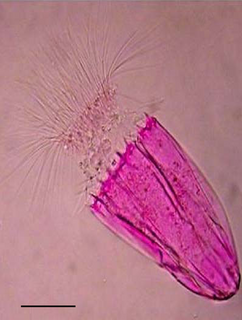Palaephatoidea is a superfamily of insects in the order Lepidoptera with a single family, Palaephatidae with seven known genera. These "Gondwanaland moths" exhibit a disjunct distribution occurring mainly in South America, with four species in eastern Australia and Tasmania and one in South Africa. The larvae spin together leaves of Proteaceae (Ptyssoptera) or Verbenaceae (Azaleodes) . Palaephatoidea, a typical monotrysian group, is one two main candidates as the sister group of most of the Lepidoptera, the Ditrysia.

Scalidophora is a group of marine pseudocoelomate protostomes that was proposed on morphological grounds to unite three phyla: the Kinorhyncha, the Priapulida and the Loricifera. The three phyla have four characters in common — chitinous cuticle that is moulted, rings of scalids on the introvert, flosculi, and two rings of introvert retracts. However, the monophyly of the Scalidophora is not supported by molecular studies, where the position of the Loricifera was uncertain or as sister to the Panarthropoda. Both studies supported a reduced Scalidophora comprising the Kinorhyncha and Priapulida as sister phyla. Their closest relatives are the Panarthropoda, Nematoda and Nematomorpha; thus they are placed in the group Ecdysozoa.

The leatherjacket fish or leather jack, Oligoplites saurus, is a species of jack in the family Carangidae. Leather jack may also refer to other members of the Carangidae, such as the pilot fish. The largest are about a foot long.

Spinoloricus cinziae is an animal species described in 2014 in the phylum Loricifera.
Cyclorhagida is an order of kinorhynchs, which are small marine invertebrates.
Millieriidae is a small family of insects in the lepidopteran order. It was described as a subfamily of Choreutidae.

Pliciloricus enigmaticus is a marine Loriciferan species of genus Pliciloricus described by Higgins & Kristensen 1986.

Pliciloricidae are a family of marine organisms in the phylum Loricifera. It contains 22 species in 3 genera.
Rugiloricus is a genus of marine organisms of the phylum Loricifera and the family Pliciloricidae, described by Higgins & Kristensen in 1986.
Rugiloricus cauliculus is a species of marine animal of the phylum Loricifera and the family Pliciloricidae. The species was described by Higgins & Kristensen in 1986, however other sources such as OBIS indicate that discovery of the species occurred on 19th November 1983.
Robert P. Higgins is an American systematic invertebrate zoologist and ecologist.
Jeanne Renaud-Mornant, Born Jeanne Renaud, Jeanne Renaud-Debyser before her second marriage was a French biologist specialising in meiofauna.
Paradoxipus orzeliscoides is a species of tardigrade. It is the only species in the genus Paradoxipus, part of the family Halechiniscidae and the subfamily Orzeliscinae. The species has been found in the coastal waters of the southeastern United States, in the western part of the Atlantic Ocean. The genus and the species were named and described by Reinhardt Kristensen and Robert P. Higgins in 1989.
Caulophilus dubius is a species of true weevil in the family of beetles known as Curculionidae. It is found in North America.
Gyrinus dubius is a species of whirligig beetle in the family Gyrinidae. It is found in North America.

Thanasimus dubius, known generally as dubious checkered beetle, is a species of checkered beetle in the family Cleridae. Other common names include the American bark beetle destroyer and checkered beetle predator. It is found in Central America and North America.
Echinoderes is a genus of mud dragons first described in 1863. It is the largest genus within class Kinorhyncha. It is a highly diverse genus, with member species that inhabit "most marine benthic substrates, on latitudes ranging from the Arctic to the tropics, and from the intertidal zone down to the deep sea." Species on the east coasts of North and South America have been extensively studied by Robert P. Higgins. Species in east Asia have been extensively studied by A. V. Adrianov.






